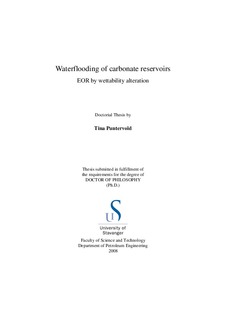| dc.contributor.author | Puntervold, Tina | |
| dc.date.accessioned | 2011-09-13T12:44:08Z | |
| dc.date.available | 2011-09-13T12:44:08Z | |
| dc.date.issued | 2008-05-30 | |
| dc.identifier.citation | Waterflooding of carbonate reservoirs : EOR by wettability alteration by Tina Puntervold, Stavanger : University of Stavanger, 2008 (PhD thesis UiS, no. 50) | en_US |
| dc.identifier.isbn | 978-82-7644-347-9 | |
| dc.identifier.issn | 1890-1387 | |
| dc.identifier.uri | http://hdl.handle.net/11250/183693 | |
| dc.description | PhD thesis in Petroleum engineering | en_US |
| dc.description | The thesis is based on the following articles, which are not yet available in Brage: | |
| dc.description | PAPER 1: Puntervold, T., Strand., S og Austad, T. (2007). Water flooding of carbonate reservoirs: Effects of a model base
and natural crude oil bases on chalk wettability.
Energy & Fuels 21(3),1606-1616.
http://pubs.acs.org/doi/pdf/10.1021/ef060624b | |
| dc.description | PAPER 2: Puntervold, T., Strand., S og Austad, T. (2007). New method to prepare outcrop chalk cores for wettability and oil
recovery studies at low initial water saturation.
Energy & Fuels 21(6), 3425-3430. http://pubs.acs.org/doi/abs/10.1021/ef700323c | |
| dc.description | PAPER 3: Puntervold, T og Austad, T. (2008) Injection of seawater and mixtures with produced water into North
Sea chalk formation: Impact of fluid-rock interactions on
wettability and scale formation.
Journal of Petroleum Science and Engineering, vol. 63(1-4), 23-33
http://www.sciencedirect.com/science/article/pii/S0920410508000636 | |
| dc.description | PAPER 4: Puntervold, T., Strand., S og Austad, T. (2007) Co-injection of seawater and produced water to improve oil
recovery from fractured North Sea chalk oil reservoirs.
Journal of Petroleum Science and Engineering (under review) | |
| dc.description | PAPER 5: Strand, S., Puntervold, T., og Austad, T. (2008). Effect of Temperature on Enhanced Oil Recovery from Mixed-Wet Chalk Cores by Spontaneous Imbibition and Forced Displacement Using Seawater. Energy & Fuels, 22(5), 3222-3225
http://pubs.acs.org/doi/abs/10.1021/ef800244v | |
| dc.description | PAPER 6: Strand, S., Austad, T., Puntervold, T., Høgnesen, E.J,. Olsen, M. og Barstad, S.M.F. (2008) “Smart Water” for Oil Recovery from Fractured Limestone: A Preliminary Study. Energy & Fuels, 22(5), 3126-3133
http://pubs.acs.org/doi/abs/10.1021/ef800062n | |
| dc.description.abstract | Oil production is generally divided into three stages, primary recovery,
secondary recovery and tertiary recovery. In primary recovery, which is
usually (but not necessarily) the first production stage, the natural energy of
the reservoir is used to displace the oil from the reservoir. The drive
mechanisms are pressure depletion of the reservoir pressure, in the form of
solution-gas drive, gas cap drive, natural water drive, or fluid and rock
expansion, or gravity drainage. In this stage, only 10-30 % of the OOIP (oil
originally in place) is produced (Castor et al., 1981).
Secondary recovery is usually initiated when primary production is
declining, adding additional energy to the reservoir in order to maintain
pressure or provide a more efficient oil displacement. Gas injection and
waterflooding are two secondary methods, the latter being the most common.
The recovery factor after the secondary stage is usually 30-50 % of OOIP
(Castor et al., 1981).
The tertiary recovery stage, comprising miscible gas injection, chemical
injection and thermal energy methods, typically takes over when secondary
recovery becomes uneconomical. However, oil production does not always
follow this chronological order. Therefore, the term ‘Enhanced Oil Recovery’
(EOR) is nowadays more widely used than ‘tertiary recovery’. Another term,
IOR (Improved oil recovery) is also often seen, and in addition to EOR this
term includes reservoir characterization, reservoir management and infill
drilling (Green and Willhite, 1998). The EOR methods most commonly target
the oil left in the waterflooded reservoir, which especially in carbonate
reservoirs can be a substantial amount. There are five categories of EOR
processes (Green and Willhite, 1998): mobility-control (polymers, foams),
chemical (surfactants, alkaline agents), miscible (hydrocarbon solvents, CO2),
thermal (steam, in-situ combustion) and other processes, such as microbial
EOR, immiscible CO2 etc. Seawater injection should perhaps be categorized
under other processes, as it is a superb EOR fluid to chalk. This will be
discussed later in chapter 3... | en_US |
| dc.language | eng | |
| dc.language.iso | eng | en_US |
| dc.publisher | University of Stavanger, Norway | en_US |
| dc.relation.ispartofseries | PhD thesis UiS;50 | |
| dc.rights | Copyright the author, all right reserve | |
| dc.subject | petroleumsteknologi | en_US |
| dc.title | Waterflooding of carbonate reservoirs : EOR by wettability alteration | en_US |
| dc.type | Doctoral thesis | en_US |
| dc.subject.nsi | VDP::Technology: 500::Rock and petroleum disciplines: 510::Petroleum engineering: 512 | en_US |
